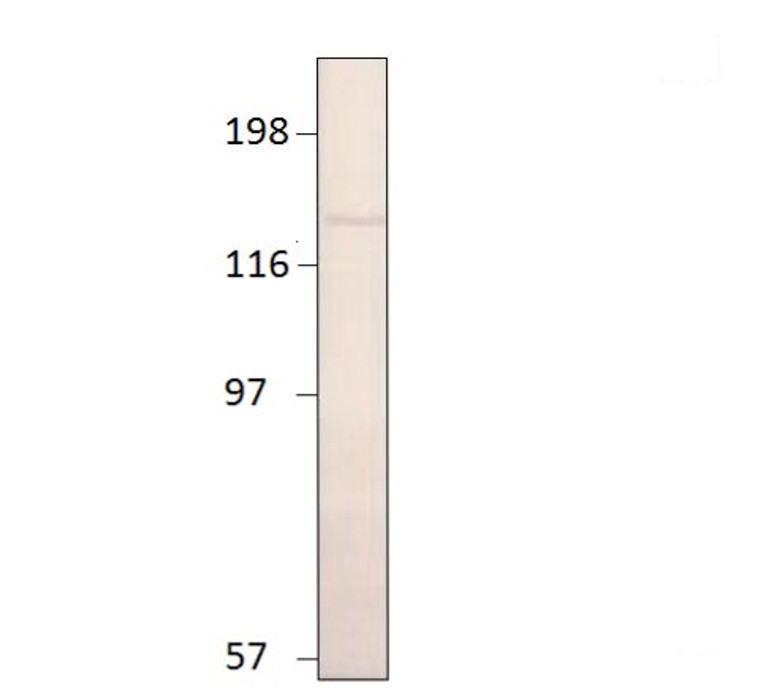| Host: |
Rabbit |
| Applications: |
ELISA/IP/WB |
| Reactivity: |
Mouse/Rat |
| Note: |
STRICTLY FOR FURTHER SCIENTIFIC RESEARCH USE ONLY (RUO). MUST NOT TO BE USED IN DIAGNOSTIC OR THERAPEUTIC APPLICATIONS. |
| Short Description: |
Rabbit polyclonal antibody anti-Timeless (1178-1197) is suitable for use in ELISA, Immunoprecipitation and Western Blot research applications. |
| Clonality: |
Polyclonal |
| Conjugation: |
Unconjugated |
| Isotype: |
IgG |
| Purification: |
Affinity Purified |
| Concentration: |
0.98-1.26 µg/µl |
| Dilution Range: |
WB: 1:500DB: 1:10, 000ELISA: 1:10, 000IP: 1:200 |
| Storage Instruction: |
Store at-20°C for long term storage. Avoid freeze-thaw cycles. |
| Gene Symbol: |
Timeless |
| Gene ID: |
21853 |
| Uniprot ID: |
TIM_MOUSE |
| Immunogen Region: |
1178-1197 |
| Immunogen: |
Synthetic peptide: SGTPRVHRKKRFQIEDEDD coresponding to amino acids 1178-1197 on Mouse Timeless protein. |
| Tissue Specificity | Predominantly and robustly expressed in proliferative organs (spleen, thymus, intestine and testis) compared to those more differentiated such as kidney and liver (at protein level). Expressed in all tissues examined including brain, heart, lung, liver, skeletal muscle, kidney, placenta, pancreas, spleen, thymus and testis. Strongly expressed in the suprachiasmatic nucleus (SCN) and pars tuberalis, moderately in the cingulate cortex, pyrimidal cell layer of the piriform cortex, periventricular part of the caudate putamen, and granular layer of the cerebellum, and weakly in the cerebral cortex, gyrus dentatus, hippocampus and thalamic nuclei. In embryonic kidney, expression is highest in regions of active ureteric bud cell branching. |
| Function | Plays an important role in the control of DNA replication, maintenance of replication fork stability, maintenance of genome stability throughout normal DNA replication, DNA repair and in the regulation of the circadian clock. Required to stabilize replication forks during DNA replication by forming a complex with TIPIN: this complex regulates DNA replication processes under both normal and stress conditions, stabilizes replication forks and influences both CHEK1 phosphorylation and the intra-S phase checkpoint in response to genotoxic stress. During DNA replication, inhibits the CMG complex ATPase activity and activates DNA polymerases catalytic activities, coupling DNA unwinding and DNA synthesis. TIMELESS promotes TIPIN nuclear localization. Plays a role in maintaining processive DNA replication past genomic guanine-rich DNA sequences that form G-quadruplex (G4) structures, possibly together with DDX1. Involved in cell survival after DNA damage or replication stress by promoting DNA repair. In response to double-strand breaks (DSBs), accumulates at DNA damage sites and promotes homologous recombination repair via its interaction with PARP1. May be specifically required for the ATR-CHEK1 pathway in the replication checkpoint induced by hydroxyurea or ultraviolet light. Involved in the determination of period length and in the DNA damage-dependent phase advancing of the circadian clock. Negatively regulates CLOCK|NPAS2-ARTNL/BMAL1|ARTNL2/BMAL2-induced transactivation of PER1 possibly via translocation of PER1 into the nucleus. May also play an important role in epithelial cell morphogenesis and formation of branching tubules. |
| Protein Name | Protein Timeless HomologMtim |
| Database Links | Reactome: R-MMU-5693607 |
| Cellular Localisation | NucleusChromosomeIn Response To Double-Strand Breaks (Dsbs)Accumulates At Dna Damage Sites Via Its Interaction With Parp1 |
| Alternative Antibody Names | Anti-Protein Timeless Homolog antibodyAnti-Mtim antibodyAnti-Timeless antibodyAnti-Tim1 antibodyAnti-Timeless1 antibody |
Information sourced from Uniprot.org
12 months for antibodies. 6 months for ELISA Kits. Please see website T&Cs for further guidance







